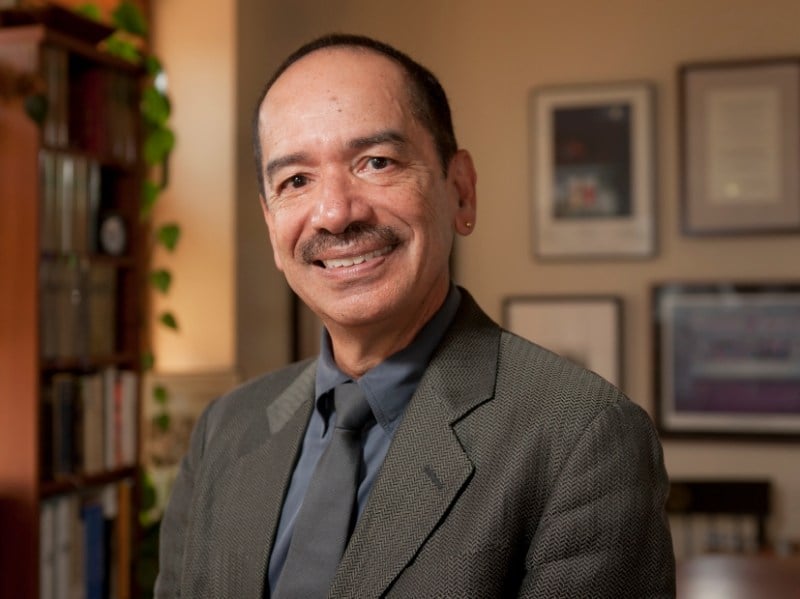
Hanging in Ramón Saldívar’s office, across from his many shelves of books, is a framed poster of “The Last Supper of the Chicano Heroes.” The mural, painted on the walls of Casa Zapata’s dining hall, bears the solemnity of a Da Vinci painting, but also brings to mind the Beatles’ “Sgt. Pepper” album cover with its medley of colorfully garbed icons including Che Guevara, Bobby Kennedy and Frida Kahlo.
As a winner of the 2011 National Humanities Medal presented by President Obama, Saldívar belongs to a distinguished group that includes writers such as Toni Morrison, John Updike and Elie Wiesel.
Last September, Saldívar became director of the Center for Comparative Studies in Race and Ethnicity (CSRE) at Stanford. For Saldívar, engaging in ethnic studies is a way of fostering a sense of commonality among America’s many different cultural identities.
Growing up in the border town of Brownsville, Texas, Saldívar was exposed to different cultures at an early age. He vividly remembers seeing the portraits of his uncles in their U.S. military uniforms standing in front of the crossed flags of Mexico and the United States.
“In a very natural way, these pictures represented our binational allegiance, the transnational identification that my family was both Mexican and American,” he said.
When Saldívar left home to attend the University of Texas at Austin, he entered a world characterized by a lack of diversity and a monolingual environment fundamentally different from the one in which he grew up.
However, as a graduate student at Yale, he found himself in an experimental atmosphere in which new ways to think about literature were developing. It was at Yale that he became well versed in European modernism and the Anglo-American tradition, which would later culminate in the publication of his first book, “Figural Language in the Novel: The Flowers of Speech from Cervantes to Joyce,” in 1984.
Inspired by the momentous events and movements of the 1970s, such as the Vietnam War, feminism, labor struggles and the civil rights movement, he chose areas of study in which the canonicity of literature was being radically rethought and reformed.
According to Saldívar, this experience had a profound impact. When he returned to the University of Texas to assume his first teaching position, he felt it was his duty “to open up our sense of why certain kinds of writing are important” and to explore under-recognized works by minorities and women.
Saldívar explored minority-centered writings in his second book published in 1990, “Chicano Narrative: The Dialectics of Difference,” which explored the narratives of Chicano communities.
“The book pioneered the field of Chicano literary studies and really helped to recognize the importance of that literary tradition from a hemispheric perspective,” said English Department Chair Gavin Jones,
Prior to this book, there was no definitive account of Chicano literature, which Saldívar found astonishing, considering the fact that certain Chicano communities had already been established for almost 180 years.
Since childhood, Saldívar had wanted to help his community in Brownsville and others like it by representing their unheard voices. He reflected that, in a way, writing Chicano Narratives afforded him that opportunity.
Saldívar said he felt that the writing process was even more meaningful because of his incorporation of the book’s material into his classes.
In addition to his extensive archival research for his third book, a biography on Mexican-American folklorist Americo Paredes, Saldívar used insights obtained from his students to help shape the final product.
“This was a book that sprang from conversation. I’d put out ideas to my students, and they’d respond,” Saldívar said. “I thought it was important to add this interactive aspect to the whole process.”
Saldívar’s target audience included young readers he hoped would take ownership of a “grand tradition of creativity and proud history” not as discussed but still belonging to this younger generation as Americans.
For Saldívar, much of the satisfaction he received from his work inside and outside of the classroom came from opening new avenues for student exploration of literature by allowing students to study writers that they might otherwise never encounter.
Saldívar connected this awakening of literature-induced awareness to his description of his own childhood.
“When you’re young the world you live in is the world,” Saldívar said. “You don’t know other ways of being.”
Saldivar said he has found that when students discover these other ways of “being” in his classes, the discovery has a meaningful impact on them.
“Sometimes two, three or four years after a student graduates, I’ll get a letter from them saying one of the books we read changed their life,” he said.
In 1994, Saldívar led a committee at Stanford that recommended bringing together the African and African American Studies Program and new programs in Asian American, Chicano and Native American studies. This led to the creation of the Center for Comparative Studies in Race and Ethnicity (CSRE) a year and a half later.
The CSRE program has since grown into a model of ethnic studies for universities across the country. According to Saldívar, it is critical that different ethnic studies be studied in concert with one another to emphasize not only the uniqueness of each culture, but also the overarching commonality that makes them all American.
“Where ethnic studies programs are not done as well is where they break down into isolated pockets, where there is no sense of each group’s relationship to a bigger set of shared issues, goals and ideals,” he said. “Here at Stanford, the ethnic studies program pays full attention and respect to the independence of individual communities, but also creates opportunities for them to work together and communicate across ethnic lines.”
Saldívar’s own work does not sit in isolation in academia. Instead, his ideas continue to profoundly affect those around him.
“As a Chicana who aspires to become a literary critic one day, I was quite moved when I watched the live stream of Professor Saldívar receiving the National Humanities Medal from my laptop,” said one of his former students, Guadalupe Carrillo, a sixth-year English graduate student. “At that moment, I realized what makes Professor Saldívar a true intellectual leader is that he not only produces good ideas, he produces ideas that touch the lives of many people in this country.”
